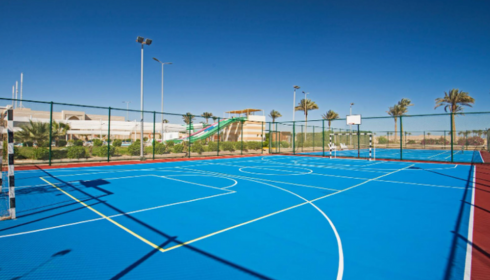A multi-purpose court is a cost-effective and space-saving solution ideal for schools, sports academies, housing societies, parks, and community centers. These versatile courts can accommodate a wide range of sports — including basketball, volleyball, badminton, tennis, futsal, and even skating — making them popular across both urban and rural India. The success of a multi-sport court depends on thoughtful multi-purpose court design, quality multipurpose court materials, and experienced execution.
Why Invest in a Multi-Purpose Court?
A single-sport court may limit usage and utility. In contrast, a well-designed multi-purpose court offers:
- Year-Round Usability: With proper surface coatings, these courts withstand all weather conditions.
- Maximized Space: Ideal for schools or urban communities with limited land.
- Reduced Cost Per Sport: One investment covers multiple activities.
- Low Maintenance: Durable synthetic surfaces require minimal upkeep.
From encouraging youth development to promoting community health, multi-use courts are practical and beneficial.
Multipurpose Court Plan: Key Design Elements
When drafting a multipurpose court plan, precision is essential. Here are the most critical design considerations:
1. Court Dimensions
A standard multi-purpose court typically ranges from:
- Minimum: 28m x 15m (suitable for basketball, futsal, and volleyball court flooring)
- Maximum: 30m x 18m (allows for added safety zones and tennis overlays)
2. Game Line Markings
- Use contrasting colors for different sports.
- Ensure markings follow respective sport federation guidelines.
- Consider removable or modular lines if needed for aesthetic or professional standards.
3. Surface Gradient & Drainage
For outdoor courts, a slight slope (around 1%) ensures water drainage and prevents surface damage.
4. Lighting & Fencing
- LED floodlights enhance visibility and extend playtime.
- Chain-link fencing ensures safety and ball containment.
5. Seating, Storage & Shade
- Include player benches, storage for equipment, and shaded areas for spectators or breaks.
Multipurpose Court Materials: Surface Options and Characteristics
Choosing the right multipurpose court flooring materials ensures longevity, performance, and safety. Here are the most common materials:
1. Synthetic Acrylic Flooring
- Non-slip, UV-resistant, and weatherproof
- Ideal for basketball, tennis, and volleyball
- Available in multiple colors and finishes
2. Polyurethane (PU) Flooring
- Seamless, shock-absorbing indoor surface
- Perfect for badminton, futsal, or gym-style courts
- Provides excellent ball bounce and joint comfort
3. Modular Interlocking Tiles
- Quick installation, portable, and customizable
- Used for temporary or mobile courts
- Slip-resistant and low-maintenance
4. Vinyl Sports Flooring
- Cushioned, durable, and widely used indoors
- Preferred for badminton, volleyball, and martial arts
5. Concrete Base with Top Coating
- Durable and cost-effective base
- Needs high-quality surface coating for grip and playability
Always ensure compatibility between base material and top-layer flooring to prevent cracking, delamination, or uneven wear.
Working with a Multipurpose Court Manufacturer
Choosing the right multipurpose court manufacturer can determine the quality and lifespan of your project. A reliable manufacturer should offer:
- Design Consultancy: Custom court layout and sport-specific planning
- Material Supply: Certified, climate-appropriate sports flooring
- Installation Support: Experienced professionals who follow global best practices
- After-Sales Service: Warranty, repairs, and maintenance guidance
Look for manufacturers with experience across multiple flooring systems and projects — from school playgrounds to stadium-level facilities.
Additional Customization Options
To enhance usability and visual appeal, you can also include:
- Logo or Branding Inlays
- Customized Color Themes
- Anti-glare or Matt Finishes
- Portable Net Posts or Goal Units
Maintenance Tips for Multi-Purpose Courts
- Clean the surface regularly to remove dust and debris
- Repaint lines every 2–3 years depending on usage
- Resurface synthetic courts every 4–6 years to restore traction and performance
- Keep drainage clear to avoid surface pooling or cracks
Final Thoughts
A well-executed multi-purpose court design can transform an empty space into a vibrant center of activity. With the right multipurpose court materials and support from an expert multipurpose court manufacturer, your facility will offer diverse sports experiences for years to come.
Whether you’re building from scratch or upgrading an old surface, plan smart, choose durable materials, and prioritize long-term usability. The result is a safe, inclusive, and engaging play space for all age groups.

